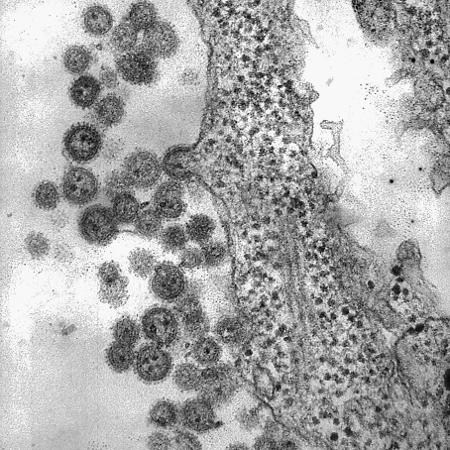Aetiology
The SAHFs are caused by 5 different clade B New World arenaviruses:
Argentine haemorrhagic fever is caused by infection with Junin virus[3][4][5]
Venezuelan haemorrhagic fever is caused by infection with Guanarito virus[6]
Bolivian haemorrhagic fever is caused by infection with Machupo virus[2]
Chapare virus infection is caused by infection with Chapare virus[8]
Brazilian haemorrhagic fever is caused by infection with Sabia virus.[9]
The viruses are members of the Arenaviridae family of RNA viruses (genus Mammarenavirus), and rodents are their natural reservoir and natural vector. The geographical limitation of the viruses is due to the presence of specific rodent vectors endemic in these regions. The following species of rodents are known vectors for certain SAHFs:[8][9][18]
Argentine haemorrhagic fever - predominantly Calomys musculinus (drylands vesper rat), but also Calomys laucha (small vesper mouse), Akodon azarae (Azara’s grass mouse, and Oryzomys flavescens (yellow pygmy rice rat[3][5]
Venezuelan haemorrhagic fever - Zygodontomys brevicauda (short-tailed cane rat[6][19]
Bolivian haemorrhagic fever - predominantly Calomys callosus (large vesper mouse).[2]
All of these vector animals are omnivorous, eating grain and small insects. The vector is unknown for Chapare virus infection and Brazilian haemorrhagic fever but is presumed to be a species of rodent.[8][9]
Exposure to rodent vectors is the key risk factor, where aerosolisation of rodent secretions and excreta can result in infection in humans either through inhalation, ingestion, or contact with broken skin or mucous membranes.[2][3][4] Community person-to-person, nosocomial, and laboratory transmission are rare, but have been described through exposure to infected bodily fluids.[2][4][5][6][9] Infection during pregnancy is uncommon, but has been described with mortality rates reported to be approximately 50% in the third trimester.[11] Fetal and neonatal death and congenital malformations have also been described.[11] Chapare virus persistence in multiple body fluids has been detected up to 170 days after symptom onset by reverse-transcriptase polymerase chain reaction (RT-PCR). Chapare virus was also isolated from a semen sample at 86 days after symptom onset.[20]
[Figure caption and citation for the preceding image starts]: Electron photomicrograph of the Machupo virusCDC Public Health Image Library (PHIL) [Citation ends].
Pathophysiology
The pathophysiology of SAHFs is not well understood. Pathogenesis has been best described for Argentine haemorrhagic fever, which is caused by the Junin virus. Human infection occurs mainly through inhalation of aerosolised secretions and excreta from infected rodents.[11] It is thought that viral replication commences at the site of infection, which is most often the lungs, but could also be the gastrointestinal tract.[4] Infection through broken skin or mucous membranes is also possible if contact is made with contaminated items or fluids.[3][4][11] Following viral replication there is widespread dissemination to other organs, including the kidneys, liver, central nervous system, and vascular endothelium.[3][4] Direct organ damage may occur from the virus, or through host response to the virus; this is often mild, but in patients with fatal disease (approximately 30%) multi-organ failure ensues.[2][3][4][6][11] Macrophages appear to be a key site of Junin virus replication, contributing to viral spread.[3][11] Cell entry appears to be mediated by transferrin receptor 1.[3][21] Activation of both complement pathways occurs, although the alternative complement pathway appears most affected, with high levels of C3 and C4 activation products.[3] The virus suppresses the early innate immune response and then creates an untoward response of cytokines and chemokines.[22][23][24] High levels of interferon alfa and tumour necrosis factor are found to correlate with increasing viraemia.[4] Other pro-inflammatory cytokines, including IL-6, IL-8, and IL-10, are also raised.[3][11][25] The increase in pro-inflammatory cytokines is likely responsible for many of the systemic symptoms (e.g., fever, arthralgia, myalgia). Immune suppression also occurs with reduced T and B lymphocyte levels, impairing the body’s ability to fight the disease.[3]
The incubation period is approximately 3-16 days, but varies between diseases. Argentine haemorrhagic fever has an incubation period of 6-14 days, whereas Bolivian haemorrhagic fever has an incubation period of 3-16 days.[2][3][4] Incubation periods have not formally been described for the other 3 SAHFs, although case descriptions suggest a similar incubation period, with a case of Venezuelan haemorrhagic fever presenting 19 days after likely exposure.[2][5][6][8][9] Although there are little data on length of viraemia in patients, early viral culture studies in Argentine haemorrhagic fever suggest that Junin virus viraemia occurs only during the acute symptomatic period; however, there are no accurate data from RT-PCR assessment of viraemia.
Haemorrhagic disease is found in approximately 30% of patients.[2][4][5][6] The pathogenesis of this does not appear to be related to disseminated intravascular coagulation, but is thought to be a result of thrombocytopenia, impaired platelet function, alterations in clotting factors (decreased factor VIII and IX, and increased factor V and von Willebrand factor), and activation and increased production of fibrinogen. Typically there is a prolonged activated partial thromboplastin time and increased fibrinogen in association with thrombocytopenia.[3][4][11]
Classification
South American haemorrhagic fevers (SAHF): regional classification
The SAHFs occur in Argentina, Venezuela, Bolivia, and Brazil. Five different clade B New World arenaviruses are responsible for causing disease in these countries:
Argentine haemorrhagic fever is caused by the Junin virus found in the Pampas region of eastern Argentina[3][5]
Venezuelan haemorrhagic fever is caused by the Guanarito virus found in Portuguesa state and Barinas state of northern Venezuela[6]
Bolivian haemorrhagic fever is caused by the Machupo virus found in the Beni district of northeastern Bolivia[2]
Chapare virus disease is caused by the Chapare virus found in the Cochabamba district of central Bolivia[8]
Brazilian haemorrhagic fever is caused by the Sabia virus, with only one naturally acquired case reported near Sao Paolo, Brazil.[9]
Baltimore classification
The viruses responsible for causing SAHFs are members of the Arenaviridae family of viruses. In the Baltimore classification, Arenaviridae viruses are classified as Group V (negative-sense single-stranded RNA viruses).
Use of this content is subject to our disclaimer